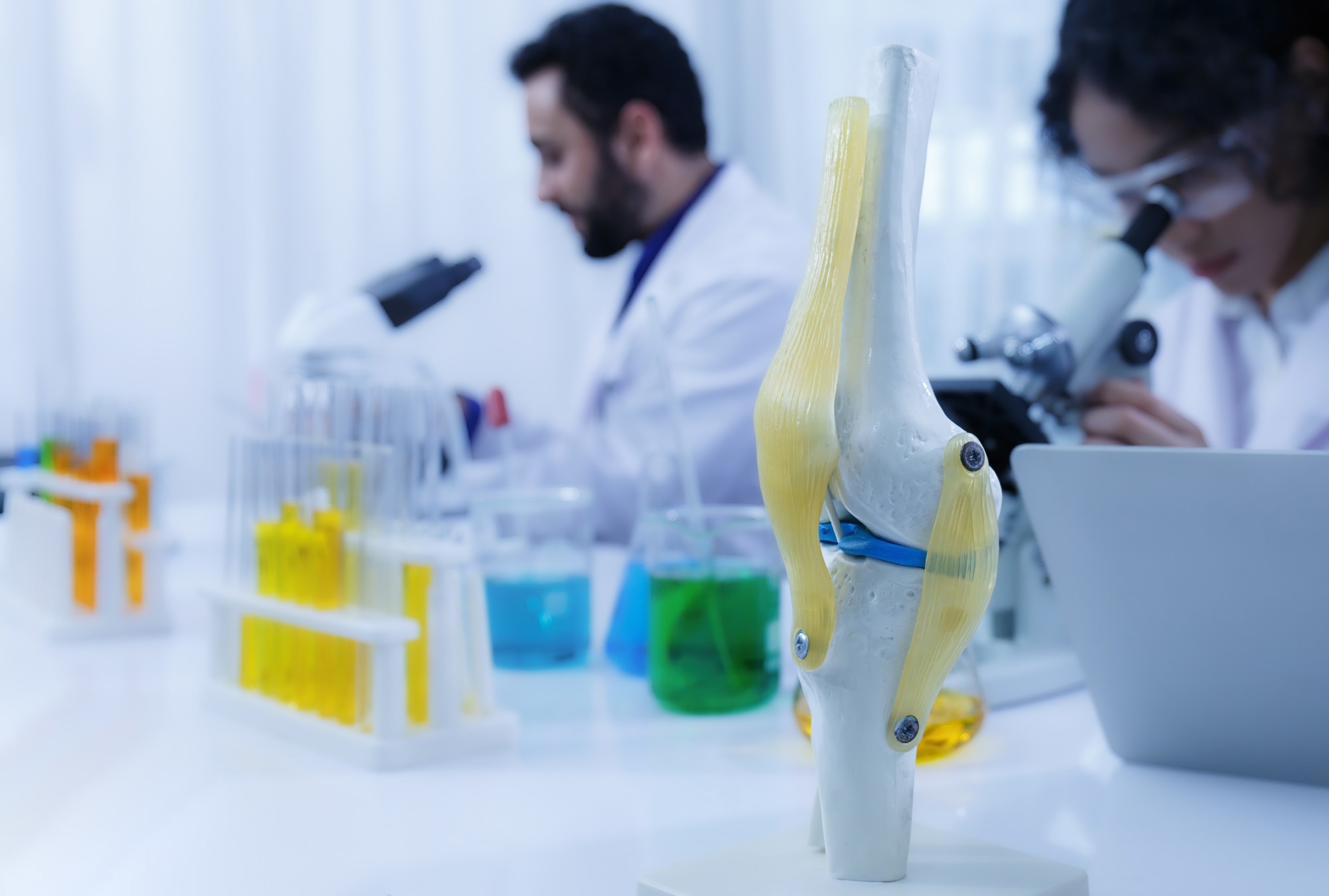 By Owais AliReviewed by Lexie CornerJul 7 2025
By Owais AliReviewed by Lexie CornerJul 7 2025Bioceramics are ceramic materials used in medicine because they can support tissue repair and interact safely with the body. They can provide structural support or promote tissue regeneration by forming direct interfaces with surrounding tissues.
 Image Credit: Atitaph_StockPHoTo/Shutterstock.com
Image Credit: Atitaph_StockPHoTo/Shutterstock.com
Materials like zirconia and alumina offer high strength, low friction, and wear resistance, making them suitable for load-bearing applications such as joint replacements and dental implants.
Other bioceramics, including hydroxyapatite (HA) and bioactive glasses, support bone growth and integration by forming bonds with biological tissues. Bioceramics also allow precise shaping and compositional tailoring, making them useful across a range of biomedical applications.1
Types of Bioceramic Materials
Bioceramic materials are categorized into three types based on their interaction with biological tissues: nearly bioinert, bioactive, and bioresorbable.
Nearly-bioinert ceramics, such as alumina (Al₂O₃) and zirconia (ZrO₂), show minimal biological interaction. They are valued for their strength, wear resistance, and chemical stability in the body.
Bioactive ceramics, including HA and bioactive glasses, can bond directly with bone. They promote remodeling through ion release and surface reactions, and their composition is similar to natural bone minerals.
Bioresorbable ceramics, such as tricalcium phosphate (TCP), gradually degrade in the body. As they resorb, they release ions that stimulate tissue regeneration. These materials act as temporary scaffolds and are eventually replaced by new tissue, avoiding the need for surgical removal.2
Current Clinical Applications
Orthopedic Applications
Orthopedic reconstructive surgery uses bioceramics like HA and TCP for bone repair due to their similarity to natural bone.
HA is often used as a coating on metal implants to improve bone integration and extend implant life. TCP is a resorbable material and is used to fill non-load-bearing bone defects. However, its low mechanical strength limits its use in load-bearing areas unless combined with stronger materials.
Recent advances in ceramic processing have enabled the development of composite bioceramics with improved strength and controlled degradation, allowing more tailored use in orthopedic procedures.1
Dental Applications
Dental Implants and Laminate Veneers
Bioceramics are widely used in restorative and prosthetic dentistry for their mechanical strength, chemical stability, and aesthetic appearance. Ceramic-based implants offer an alternative to titanium by avoiding gum discoloration and improving tissue compatibility.
Zirconia, initially used as a coating, is now a common implant material. Yttria-stabilized tetragonal zirconia polycrystals (Y-TZP) have become the clinical standard due to their toughness and corrosion resistance. Most implants are single-piece, though research into two-piece designs continues.
In cosmetic dentistry, ceramic laminate veneers made from feldspathic porcelain, leucite-reinforced glass ceramics, and lithium disilicate are used for minimally invasive front tooth restoration. These materials offer good translucency and strength, though problems like microleakage and fractures continue to drive material improvements.
Ceramics in Endodontics
In endodontics, bioceramics are used for their compatibility with tissue, sealing ability, and support for healing around the tooth root. Mineral trioxide aggregate (MTA), made of tricalcium oxide, silicon dioxide, and bismuth oxide, is commonly used in root repair. It sets in moist conditions and forms calcium hydroxide, which improves antibacterial activity and helps maintain structure.
Bioceramic-based sealers and repair materials are also used in root canals to reduce leakage and support tissue regeneration. These materials interact with the surrounding environment to promote healing and are now standard in modern endodontic procedures.3
Surface Coatings
Metallic implants, widely used in hard tissue replacement, often face limitations such as poor biological integration and the release of harmful metal ions. To address these concerns, ceramic-based surface coatings are applied to enhance biocompatibility, corrosion resistance, and osseointegration.
Bioinert coatings like Al₂O₃, titania (TiO₂), and ZrO₂ improve mechanical strength but have limited biological interaction due to their high elastic modulus and low bioactivity.
Bioactive coatings made from calcium phosphate and glass ceramics more closely match bone composition. They support cell attachment, growth, and faster healing. These coatings also protect against corrosion and reduce metal ion release, which can extend the lifespan of the implant.
Bone Tissue Engineering
In bone tissue engineering, bioceramics are used in scaffolds that support the repair and growth of damaged or diseased bone.
Polymer–ceramic composites are commonly used to mimic the structure of natural bone. Ceramics like hydroxyapatite and tricalcium phosphate provide strength, while polymers add flexibility and biodegradability. These materials support bone integration by encouraging cell growth and attachment, helped by their chemical similarity to natural bone.
Recent advances in additive manufacturing—such as selective laser sintering (SLS), stereolithography (SLA), and fused deposition modeling (FDM)—have made it possible to produce scaffolds with precise porosity, shape, and strength. These technologies allow the creation of custom bioceramic structures designed to match patient needs and improve healing.4
First Ever Clinical Long-Term Follow-Up Study on 3D-Printed Bioceramic Implants
Recent Innovations
Nanobioceramics in Wound Healing
The skin acts as a protective barrier, but is highly vulnerable to injury due to constant exposure. Traditional wound dressings mostly provide passive coverage and often lack the ability to support cell activity needed for proper healing. This has led to interest in advanced materials that can offer both protection and biological support.
One challenge in current wound dressing design is combining structural, mechanical, and biological performance, especially in electrospun fibrous membranes.
To address these issues, a study published in Colloids and Surfaces A: Physicochemical and Engineering Aspects developed a composite scaffold by incorporating bioceramic hardystonite (Ca₂ZnSi₂O₇) into a polycaprolactone (PCL) and tetrafluoroethylene (TPE) matrix via near-field electrostatic spinning.
The Ca²⁺ and Zn²⁺ ions in hardystonite enhanced electrical conductivity, reducing fiber diameter through increased tensile forces. Higher hardystonite content increased solution viscosity, producing thicker fibers. These interactions allowed precise tuning of fiber morphology.
The resulting scaffold exhibited improved cell migration, viability, and differentiation, while the porous structure enabled enhanced oxygen exchange compared to cast membranes.
This approach demonstrates the potential of bioceramic-enhanced materials to advance wound healing by providing both structural support and biological functionality.5
Fast-Track Production of Hydroxyapatite Scaffolds for Bone Repair
Bone defects caused by trauma, congenital abnormalities, or disease present significant clinical challenges, often impairing patient mobility and quality of life. Traditional treatments, such as bone grafts and synthetic implants, face limitations in biocompatibility, integration, and durability.
Bone tissue engineering offers a promising alternative by developing porous, biodegradable scaffolds that support bone regeneration. However, conventional fabrication methods often require lengthy processing times and struggle to precisely control scaffold porosity and phase composition, which are critical for optimal biological performance.
To improve scaffold fabrication, a recent study introduced a rapid sol-gel synthesis method for HAp-based bioceramics, eliminating the prolonged aging of traditional techniques. This approach employed calcium acetate and, for the first time, calcium nitrate precursors with hydrogen peroxide (3–10 wt%) as a pore-forming agent.
Calcination at 400 °C produced pure HAp, while 700 °C yielded mixtures of HAp and β-tricalcium phosphate (β-TCP), influencing bioactivity and cytocompatibility. All samples exhibited effective mineralization in simulated body fluid and high osteoblast viability, reaching 139 % in optimal cases.
The findings indicate that while porosity aids cell anchorage, phase composition—particularly β-TCP and residual carbon content—more strongly affects cytocompatibility. This method provides a rapid, scalable route to bioceramic scaffolds with tunable structural and biological properties, enhancing potential clinical outcomes in bone tissue engineering.6
Looking Ahead: Where Bioceramics Are Headed
Bioceramics will continue to evolve through developments in tissue engineering, implant design, and drug delivery. New techniques are improving scaffold performance, enabling better integration with cells and tissues. Smart coatings and custom implants are also extending the lifespan and function of biomedical devices.
For a broader perspective on where these technologies are going, explore An Overview of Biomaterials: Advancements and Applications. To learn how materials like silicone complement bioceramics in clinical settings, see The Use of Silicone in Medicine. And for insights into future fabrication methods, check out 3D Bioprinting: Market Trends and Innovations.
References and Further Reading
- Vaiani, L., Boccaccio, A., Uva, A. E., Palumbo, G., Piccininni, A., Guglielmi, P., Cantore, S., Santacroce, L., Charitos, I. A., & Ballini, A. (2023). Ceramic Materials for Biomedical Applications: An Overview on Properties and Fabrication Processes. Journal of Functional Biomaterials, 14(3), 146. https://doi.org/10.3390/jfb14030146
- Cui, W., Cao, L., & Zhang, X. (2021). Bioceramics: Materials, properties, and applications. Ceramic Science and Engineering, 65-110. https://doi.org/10.1016/B978-0-323-89956-7.00017-6
- Raghavendra, S. S., Jadhav, G. R., Gathani, K. M., & Kotadia, P. (2017). Bioceramics in endodontics – a review. Journal of Istanbul University Faculty of Dentistry, 51(3 Suppl 1), S128. https://doi.org/10.17096/jiufd.63659
- Gunduz, O., Egles, C., Pérez, R. A., Ficai, D., & Ustundag, C. B. (Eds.). (2023). Biomaterials and Tissue Engineering. Cham, Switzerland: Springer. https://doi.org/10.1007/978-3-031-35832-6
- Yao, Q., Wang, C., Yu, B., Wang, P., Tang, X., Shi, D., Xia, Y., Hu, Y., Li, S., & Zhou, W. (2023). Well-ordered and visual poly(ε-caprolactone) composite fibrous membranes for the treatment of skin wounds. Colloids and Surfaces A: Physicochemical and Engineering Aspects, 674, 131940. https://doi.org/10.1016/j.colsurfa.2023.131940
- Bertocco, A., Capela, M., Caetano, A. P., Nito, A., Quarta, A., Seabra, M. P., & Pullar, R. C. (2025). Porous hydroxyapatite – β-tricalcium phosphate ceramics produced from a rapid sol-gel process. Scientific Reports, 15(1), 1-15. https://doi.org/10.1038/s41598-025-01253-2
- Iulian Vasile Antoniac. (2020). Handbook of Bioceramics and Biocomposites. SpringerLink. https://doi.org/10.1007-978-3-319-09230-0
Disclaimer: The views expressed here are those of the author expressed in their private capacity and do not necessarily represent the views of AZoM.com Limited T/A AZoNetwork the owner and operator of this website. This disclaimer forms part of the Terms and conditions of use of this website.